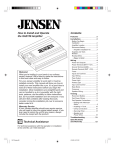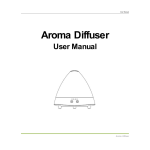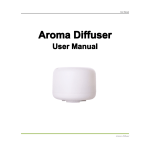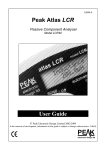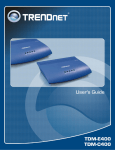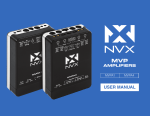Download STA220 STA216 STA212 STA208 STA206 STA416 STA412
Transcript
USER’S MANUAL STA220 STA216 STA212 STA208 STA206 STA416 STA412 Two Channel MOSFET Car Audio Amplifiers Four Channel MOSFET Car Audio Amplifiers Congratulations on your purchase of a Sound Storm Laboratories STEALTH Amplifier. It has been designed, engineered and manufactured to bring you the highest level of performance and quality, and will afford you years of listening pleasure. Thank you for making Sound Storm Laboratories your choice for car audio entertainment! page CONTENTS 2 Introduction 2 What is included? 3 Features 3 About 2 Ohm operation 4 General precautions 4 Installation precautions 4 Mounting the amplifier 5 Connecting the amplifier 6 Low level input wiring 7 High level input wiring 8 2CH Power and Speaker wiring 2CH Mode 9 2CH Power and Speaker wiring Bridged Mode 10 2CH Power and Speaker wiring TriMode 11 4CH Power and Speaker wiring 4CH Mode 12 4CH Power and Speaker wiring Bridged Mode 13 4CH Power and Speaker wiring TriMode 14 Troubleshooting 15 Specifications STEALTH MOSFET Amplifier User’s Manual - page 1 Introduction What is included? With the Sound Storm Laboratories STEALTH MOSFET amplifier series, we are introducing seven new amplifiers, all designed in the USA. This new series includes five 2-channel and two 4-channel amplifiers. When first unpacking your new amplifier, please check first that the package contains all of the items below. If something is missing, contact the store where you purchased the amplifier. All STEALTH models feature variable low pass crossovers and variable input gain controls. They also incorporate a fixed high pass crossover for added system flexibility. • STEALTH amplifier For further flexibility in the use of a subwoofer, 0-+18dB Bass Boost control has been included on all amplifiers. You can control the subwoofer level with the remote level control module. Sound Storm Laboratories understands that amplifiers are placed in many different kinds of installations, so we incorporated a very flexible system of controls in these amplifiers in order to help you integrate the amp into your system regardless of the nature of your input source. STEALTH MOSFET Amplifier User’s Manual - page 2 • Remote subwoofer level control •High input cable with connector • Four (4) mounting screws Features About 2 Ohm operation Your new STEALTH amplifier features the following: Your STEALTH amplifier has been designed to operate efficiently at loads down to 2 Ohms. This means that you can install four 8 Ohm speakers per channel, when using parallel wiring. • Class A-B operation • Bridgeable outputs • Tri-Mode capable • MOSFET PWM (Pulse Width Modulated) Power Supply • 2 Ohm stable stereo operation with output power increase • Thermal and speaker short protection • Soft turn-on circuit • Remote turn-on/turn-off circuit • Variable input gain control Increasing the number of woofers per channel at low frequencies (below 100Hz) produces an acoustic coupling effect. This acoustic coupling effect increases your power output by about 3dB per speaker, or the equivalent of an additional 10W per speaker. When operating at 2 Ohms, the amplifiers will increase their output power by approximately 50%. The current draw will also increase by about the same amount, so be sure you have enough current to run the amplifiers into a 2 Ohm load. If you lack adequate current, your music reproduction will be distorted. • Variable low pass crossover(s) • Fixed high pass crossover (200Hz) • Variable 0 to +18dB Bass Boost • Nickel-plated RCA low level and high level inputs • LED power and protection indicators • Silver anodized heatsink • Remote subwoofer level control STEALTH MOSFET Amplifier User’s Manual - page 3 General precautions Before installing and using your new Sound Storm Laboratories amplifier, please become familiar with all the information contained in this manual. Please keep this manual in a safe place for future reference. • Do not open or attempt to repair this unit yourself. Dangerous high voltages are present which may result in electric shock. Refer any repairs to a qualified service technician. • To avoid risk of electronic shock or damage to the amplifier, do not permit any of this equipment to become damp or wet from water or drinks. If this does occur, immediately unplug the power wires and send the amplifier to your local dealer or service center as soon as possible. • If there is smoke or any peculiar odor present during use or if there is damage to any of the component enclosures, immediately unplug the power wire and send the amplifier to your local dealer or service center as soon as possible . Installation precautions Before you drill or cut any holes, investigate your car's layout very carefully. Take special care when you work near the gas tank, fuel lines, hydraulic lines and electrical wiring. Never operate the amplifier when it is unmounted. Attach all audio system components securely to prevent damage, especially in an accident. STEALTH MOSFET Amplifier User’s Manual - page 4 Before making or breaking power connections in your system, disconnect the vehicle battery. Confirm that your head unit or other equipment is turned off while connecting the input jacks and speaker terminals. If you need to replace the power fuse, replace it only with a fuse identical to that supplied with the amplifier. Using a fuse of a different type or rating may result in damage to your audio system or your amplifier which is not covered by the manufacturer's warranty. Mounting the amplifier 1. Find a suitable location in the vehicle in which to mount the amplifier. 2. Make sure there is sufficient air circulation around the intended mounting location. 3. Mark the location for the mounting hole screws by positioning the amplifier where you wish to install it. Use a scribe or mounting screw, inserted through each of the amp's mounting holes, to mark the mounting surface. If the mounting surface is carpeted, measure the hole centers and mark with a felt tip pen. 4. Drill pilot holes in the mounting surface for the mounting screws. Place the amplifier in position, and attach the amplifier to the mounting surface securely using screws. SHOCK HAZARD! Do not open the case of this product. There are dangerous voltages present within the unit. There are no user-serviceable parts within the unit. Connecting the amplifier Before doing any wiring, look through this manual and identify the diagrams to follow for power, input and speaker connections for your particular installation. Be sure you understand all the connections before you proceed. 1. Connect the power ground terminal to the closest point on the chassis of the car. Keep this ground wire to less than 39" (100 cm) in length. Use 8 gauge (or heavier) wire. 2. Connect the remote terminal to the remote output of the head unit using 16 gauge (or heavier) wire. 3. Connect an empty fuse holder within 18" (45 cm) of the car battery, and run 8 gauge (or heavier) cable from this fuse to the amplifier location. 7. Insert fuse(s) into the battery fuse holder(s). 8. Recheck all connections before powering up the amplifier. 9. Set all level controls to minimum position, and set all crossover controls/switches to the desired frequency points. 10. Power up the head unit and the amplifier. Then set the volume control on the head unit to about 3/4 volume, and adjust the amplifier’s input level control(s) to just below the level of distortion. 11. Further fine tuning of the various controls may be necessary to obtain best results. 4. Check that the fuse holder is empty. Then connect the fuse holder to the "BATT+" connection on the amplifier. 5. If multiple amplifiers are being used in your system, either: • Run a separate pair of cables from the battery and a chassis ground point to each amplifier. Each (+) cable must have its own inline fuse. -or• Run a #4 cable from the fuse holder at the battery to a distribution block at or near the amplifier's location. Then run separate cables from the amplifier to this distribution block and to independent chassis ground points. 6. Connect all line inputs and outputs (if used) using high-quality cables. Connect all speakers, following the diagrams in this manual. Be sure to observe proper polarity to avoid audio phase problems. Don't misuse the level control! Do not mistake the input level control for a volume control! It is designed ONLY to match the output level of your audio source to the input level of your amplifier. Do not adjust this input level to maximum unless your input level requires it. Ignoring these instructions will result in an input overload to the amplifier, and excessive audio distortion. It can also cause the protection circuit to engage. STEALTH MOSFET Amplifier User’s Manual - page 5 Low Level Input Wiring Low-level (RCA) input wiring is preferred for best audio performance. Always use a high-quality RCA cable for best audio performance. NOTE: Do not connect BOTH the high level and low level inputs from your receiver to your amplifier at the same time! 2-Channel Amplifiers STA206, STA208, STA212, STA216 and STA220 Remote Subwoofer Level Control To Audio Outputs of head unit or signal processor 4-Channel Amplifiers STA412 and STA416 Remote Subwoofer Level Control To REAR Audio Outputs of head unit or signal processor STEALTH MOSFET Amplifier User’s Manual - page 6 To FRONT Audio Outputs of head unit or signal processor High Level Input Wiring The high level input(s) should only be used when your head unit lacks RCA outputs. If the RCA outputs are not present, connect the speaker outputs from the receiver to the high level input connector of the amplifier. Be sure to observe polarity to avoid audio phase problems. NOTE: Do not connect BOTH the high level and low level inputs from your receiver to your amplifier at the same time! 2-Channel Amplifiers STA206, STA208, STA212, STA216 and STA220 Remote Subwoofer Level Control L+ 4-Channel Amplifiers STA412 and STA416 L- R- R+ CH CH CH 1+ 1- 2- 2+ CH Remote Subwoofer Level Control CH CH CH 3+ 3- 4- 4+ CH To Speaker Terminals of head unit To Speaker Terminals of head unit To Speaker Terminals of head unit STEALTH MOSFET Amplifier User’s Manual - page 7 Power and Speaker Wiring 2-Channel Amplifiers 2 Channel Mode STA206, STA208, STA212 STA216 and STA220 RIGHT Speaker Two Channel Mode SPEAKER IMPEDANCE 2-8 OHMS GN D RE M LEFT Speaker B AT T + L R BR IDG ED MO DE F U S ES Chassis ground point Connect the Positive (+) terminal of the subwoofer to the R (+) amplifier terminal. Connect the Negative (-) terminal of the subwoofer to the L (-) amplifier terminal. to REMOTE TURN-ON terminal of head unit Battery FUSE STEALTH MOSFET Amplifier User’s Manual - page 8 Power and Speaker Wiring 2-Channel Amplifiers Bridged Mode STA206, STA208, STA212 STA216 and STA220 Subwoofer Bridged Mode SPEAKER IMPEDANCE 4-8 OHMS GN D RE M B AT T + L R BR IDG ED MO DE F U S ES Chassis ground point Connect the Positive (+) terminal of the subwoofer to the R (+) amplifier terminal. to REMOTE TURN-ON terminal of head unit Connect the Negative (-) terminal of the subwoofer to the L (-) amplifier terminal. Battery FUSE STEALTH MOSFET Amplifier User’s Manual - page 9 Power and Speaker Wiring 2-Channel Amplifiers Tri-Mode STA206, STA208, STA212 STA216 and STA220 Tri-mode operation allows you to connect this amplifier to a pair of main speakers plus a subwoofer on one pair of output channels. The main speakers will operate in STEREO while the subwoofer simultaneously operates in MONO. To set up the amplifier to run in this mode, put the crossover switches in the FULL position. Insert high pass filter capacitors and a low pass filter inductor into the wiring as shown below. Be sure to check the table at the bottom of this page to determine the correct capacitor and inductor values for the crossover frequency you wish to achieve. Component values for 6dB Passive Crossover FREQUENCY INDUCTOR CAPACITOR 80 Hz 100 Hz 120 Hz 150 Hz 7.5mH 6.5mH 5.5mH 4mH Tri-Mode to REMOTE TURN-ON terminal of head unit Battery FUSE GN D RE M B AT T + L R BR IDG ED MO DE F U S ES Chassis ground point High pass filter crossover LEFT Speaker MINIMUM SPEAKER IMPEDANCE 4 OHMS High pass filter crossover RIGHT Speaker Low pass filter inductor Subwoofer SPEAKER IMPEDANCE 8 OHMS STEALTH MOSFET Amplifier User’s Manual - page 10 470uF 330uF 330uF 220uF Power and Speaker Wiring 4-Channel Amplifiers 4 Channel Mode SPEAKER IMPEDANCE 2-8 OHMS STA412 and STA416 CH3 Speaker CH4 Speaker Four Channel Mode BR IDG ED MOD E GN D RE M B AT T + CH4 CH3 BR IDG ED MOD E CH2 CH1 F USE S Chassis ground point CH2 Speaker to REMOTE TURN-ON terminal of head unit CH1 Speaker Battery SPEAKER IMPEDANCE 2-8 OHMS FUSE STEALTH MOSFET Amplifier User’s Manual - page 11 Power and Speaker Wiring 4-Channel Amplifiers Bridged Mode STA412 and STA416 Connect the Negative (-) terminal of the RIGHT subwoofer to the CH4(-) amplifier terminal. SPEAKER IMPEDANCE 4-8 OHMS Connect the Postive (+) terminal of the RIGHT subwoofer to the CH3(+) amplifier terminal. RIGHT Subwoofer Bridged Mode BR IDG ED MOD E GN D RE M B AT T + CH4 CH3 BR IDG ED MOD E CH2 CH1 F USE S Chassis ground point to REMOTE TURN-ON terminal of head unit Battery SPEAKER IMPEDANCE 4-8 OHMS LEFT Subwoofer FUSE Connect the Negative (-) terminal of the LEFT subwoofer to the CH2(-) amplifier terminal. Connect the Postive (+) terminal of the LEFT subwoofer to the CH1(+) amplifier terminal. STEALTH MOSFET Amplifier User’s Manual - page 12 Power and Speaker Wiring 4-Channel Amplifiers Tri-Mode STA412 and STA416 Tri-mode operation allows you to connect this amplifier to a pair of main speakers plus a subwoofer on one pair of output channels. The main speakers will operate in STEREO while the subwoofer simultaneously operates in MONO. To set up the amplifier to run in this mode, put the crossover switches in the FULL position. Insert high pass filter capacitors and a low pass filter inductor into the wiring as shown below. Be sure to check the table at the bottom of this page to determine the correct capacitor and inductor values for the crossover frequency you wish to achieve. SPEAKER IMPEDANCE 8 OHMS Tri-Mode RIGHT Subwoofer Component values for 6dB Passive Crossover CH4 Speaker FREQUENCY INDUCTOR CAPACITOR 80 Hz 100 Hz 120 Hz 150 Hz 7.5mH 6.5mH 5.5mH 4mH MINIMUM SPEAKER IMPEDANCE 4 OHMS High pass filter crossover 470uF 330uF 330uF 220uF CH3 Speaker High pass filter crossover Low pass filter inductor BR IDG ED M OD E GND REM B AT T + CH4 CH3 BR IDG ED M OD E CH2 CH1 F USE S Chassis ground point to REMOTE TURN-ON terminal of head unit High pass filter crossover + – Battery CH1 Speaker MINIMUM SPEAKER IMPEDANCE 4 OHMS FUSE High pass filter crossover + – SPEAKER IMPEDANCE 8 OHMS CH2 Speaker Low pass filter inductor LEFT Subwoofer STEALTH MOSFET Amplifier User’s Manual - page 13 Troubleshooting If you experience operation or performance problems with this product, compare your installation with the electrical wiring diagram on the previous pages. If problems persist, read the following troubleshooting tips which may help eliminate the problems. SYMPTOM POSSIBLE REMEDY Amplifier will not power up. Check to make sure you have a good ground connection. Check that the Remote Input (Turn-On) has at least 3VDC. Check that there is battery power on the (+) terminal. Check that there is at least 12v. Check all fuses, replace if necessary. Make sure that the Protection LED is not illuminated. If it is lit, shut off the amplifier briefly, and then repower it. Protection LED comes on when amplifier is powered up. Check for short circuits on speaker leads. Turn down the volume control on the head unit to prevent overdriving. Remove speaker leads, and reset the amplifier. If the Protection LED still comes on, then the amplifier is faulty and needs servicing. No output. Check that all fuses are OK. Check that amplifier is properly grounded. Check that the Remote Input (Turn-On) has at least 3VDC. Check that the RCA audio cables are plugged into the proper inputs. Check all speaker wiring. Low output. Reset the Level Control. Check the Crossover Control settings. Audio present in only one channel. Check the RCA interconnect cables. Check all speaker wiring. High hiss in the speakers. Disconnect all RCA inputs to the amplifiers. If the hiss disappears, then plug in the component driving the amplifier and unplug its inputs. If the hiss disappears at this point, go on until the faulty/noisy component is found. It is best to set the amplifier's input level control as low as possible. The best subjective signal-to-noise ratio is achieved in this manner. Try to set the head unit as high as possible (without distortion) and the amp input level as low as possible. Squealing noise from speakers. Check for improperly grounded RCA interconnects. Distorted sound. Check that the Input Level Control is set to match the signal level of the head unit. Always try to set the Input Level as low as possible. Check that all crossover frequencies are properly set. Check for short circuits on the speaker leads. Amplifier gets very hot. Check that the minimum speaker impedance for the amp model is correct. Check that there is good air circulation around the amp. In some applications, it may be necessary to add external cooling fan(s). Engine noise (static type) This is usually caused by poor quality RCA cables,which can pick up radiated noise. Use only the best quality cables, and route them away from power cables. Engine noise (alternator whine) Check that speaker leads are not shorted to the vehicle chassis. Check that the RCA grounds are not shorted to the vehicle chassis. Check that the head unit is properly grounded. STEALTH MOSFET Amplifier User’s Manual - page 14 Specifications Two Channel MOSFET Car Audio Amplifiers MODEL STA206 STA208 STA212 STA216 STA220 RMS POWER 140W x 2 170W x 2 230W x 2 290W x 2 360W x 2 300W X 2 400W X 2 600W X 2 800W X 2 1000W X 2 600W X 1 800W x 1 1200W x 1 1600W x 1 2000W x 1 into 4 Ohms MAX POWER into 2 Ohms BRIDGED POWER into 4 Ohms Min. speaker impedance THD Frequency response 2 Ohm Stereo 2 Ohm Stereo 2 Ohm Stereo 2 Ohm Stereo 2 Ohm Stereo 4 Ohm Mono Bridged 4 Ohm Mono Bridged 4 Ohm Mono Bridged 4 Ohm Mono Bridged 4 Ohm Mono Bridged 0.01% 0.01% 0.01% 0.01% 0.01% 9Hz-50kHz 9Hz-50kHz 9Hz-50kHz 9Hz-50kHz 9Hz-50kHz Signal-to-noise ratio Channel separation 105dB 90dB 103dB 90dB 103dB 90dB 103dB 90dB 103dB 90dB Damping factor Crossover range 125+ 125+ 125+ 125+ 125+ low pass 40Hz-150Hz 35Hz-160Hz 35Hz-160Hz 35Hz-160Hz 35Hz-160Hz 200Hz (fixed) 200Hz (fixed) 200Hz (fixed) 200Hz (fixed) 200Hz (fixed) Variable 0 - +18dB Variable 0 - +18dB Variable 0 - +18dB Variable 0 - +18dB Variable 0 - +18dB high pass Bass boost Fuse rating Dimensions: (11-1/4" x 3" x ...) 20A x 1 6-5/8" 25A x 1 9" MODEL STA412 STA416 RMS POWER 220W x 4 250W x 4 300W X 4 400W X 4 600W X 2 800W x 2 25A x 1 11" 20A x 2 12-1/2" 25A x 2 17-5/8" Four Channel MOSFET Car Audio Amplifiers into 4 Ohms MAX POWER into 2 Ohms BRIDGED POWER into 4 Ohms Min. speaker impedance THD Frequency response Signal-to-noise ratio 2 Ohm Stereo 2 Ohm Stereo 4 Ohm Mono Bridged 4 Ohm Mono Bridged 0.01% 0.01% 9Hz-50kHz 9Hz-50kHz 103dB 105dB Channel separation Damping factor 90dB 125+ 90dB 125+ low pass 40Hz-150Hz 35Hz-160Hz high pass 200Hz (fixed) 200Hz (fixed) Variable 0 - +18dBVariable 0 - +18dB Crossover range Bass boost Fuse rating Dimensions: (11-1/4" x 3" x ...) 40A x 1 11" 25A x 2 13-3/4" All specifications subject to change without notice. STEALTH MOSFET Amplifier User’s Manual - page 15 Notes






















